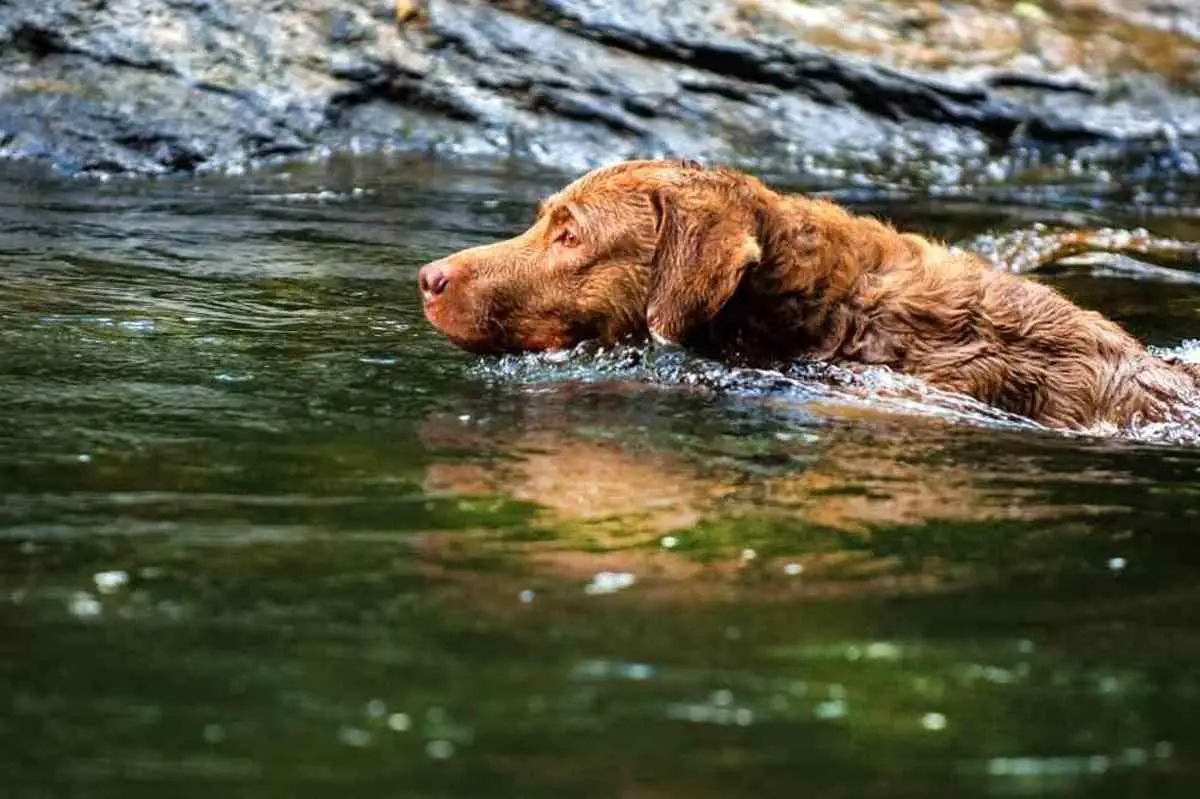Quick Links: Table of Contents
- Chesapeake Bay Retriever Breed Overview
- History of the Chesapeake Bay Retriever Breed. Where Chesapeake Bay Retrievers came from
- What the Chesapeake Bay Retriever Looks Like
- How Much is the Chesapeake Bay Retriever Puppy?
- Best Chesapeake Bay Retriever Breeders
- Adopting or Rescuing the Chesapeake Bay Retriever
- What Colors do Chesapeake Bay Retrievers Have?
- The Temperament of the Chesapeake Bay Retriever
- How Long Chesapeake Bay Retrievers Live
- Chesapeake Bay Retriever Litter Size
- How Fast Chesapeake Bay Retrievers Can Run
- Good Names for Chesapeake Bay Retrievers
- How Intelligent are Chesapeake Bay Retrievers?
- How Popular are Chesapeake Bay Retrievers with New Dog Owners?
- Health Problems in Chesapeake Bay Retrievers and How to Prevent Them
- Dog Breeds That Are Similar to Chesapeake Bay Retrievers
- Other Things to Know About Chesapeake Bay Retrievers
Chesapeake Bay Retriever Breed Overview
The Chesapeake Bay Retriever is a medium-sized dog.
The adult Chesapeake Bay Retriever stands 1 foot, 9 inches to 2 feet, 2 inches tall at the s.
The Chesapeake Bay Retriever belongs to the Sporting Dogs group.
Dogs in the Sporting Dogs group, like the Chesapeake Bay Retriever, were bred to help hunters catch and retrieve feathered game. Some sporting dog breeds such as Retrievers, which were built for swimming, were bred to hunt waterfowl in water.
Whereas sporting dog breeds like setters, spaniels, and pointing breeds were bred to hunt quail, pheasant, and other game birds nest on grasslands.
Many Sporting Group breeds have thick, water-repellent coats that protect them from harsh hunting conditions.
The fact that the Chesapeake Bay Retriever belongs to the Sporting Dogs group is one of the reasons why Chesapeake Bay Retrievers have the personality and temperament that they have.
The temperament of the Chesapeake Bay Retriever is generally described as:
- Affectionate
- Dominant
- Happy
- Intelligent
- Protective
- Quiet
History of the Chesapeake Bay Retriever Breed. Where Chesapeake Bay Retrievers came from
The name Chesapeake Bay Retriever has a very literal origin.
Dogs from both Chesapeake Bay shores were recognized in 1877 as one of three varieties of the Chesapeake Bay Ducking Dog, which was consolidated in 1918 as the single Chesapeake Bay Retriever.
The genetic line of the breed can be traced back to 1807, when two puppies were rescued from a sinking ship in Maryland.
The agile dogs were apparently given to the rescuers as a token of appreciation.
The puppies developed into skilled water retrievers, and it is said that the two saved dogs were bred with local dogs such as Hounds and Water Spaniels.
Furthermore, sources claim the breed descended from crosses with the English Otterhound, flat-coated Retriever, and curly-coated Retriever.
The distinct breed has evolved over time.
.
What the Chesapeake Bay Retriever Looks Like
When the Chesapeake Bay Retriever emerges from the water, his coat appears to be barely wet.
The wavy coat is double-layered with oil in each layer and is designed to dry quickly.
The undercoat is dense and woolly, as is the fur on the legs.
This breed is a strong, muscular dog that is slightly longer than it is tall, with hindquarters that are as high as, if not higher than, the forequarters.
The legs of this Retriever are quite powerful, and the webbed feet have well-rounded toes.
The eyes are wide-set, medium to large, and have an inquisitive expression.
The muzzle is tapered, and the teeth come together in a scissors or level bite.
The tail is medium in length.
.
How Much is the Chesapeake Bay Retriever Puppy?

The average price of a Chesapeake Bay Retriever puppy is $1130. The price of a Chesapeake Bay Retriever puppy ranges from $850 to $1200.
A lot of factors determine the price of the Chesapeake Bay Retriever. These factors include what health records the Chesapeake Bay Retriever puppy has, the lineage of the Chesapeake Bay Retriever puppy, the US state the breeder is located in, etc.
To estimate how much you can expect to pay for a puppy Chesapeake Bay Retriever based on the many factors that determine the price of the Chesapeake Bay Retriever puppy, check out our calculator that lets you estimate how much you should expect to pay for the Chesapeake Bay Retriever puppy based on what you want in the puppy.
When looking to buy a puppy, look at buying a puppy only from well-established breeders that breed puppies primarily for the love of the Chesapeake Bay Retriever breed, and secondarily for profit. Do not buy a puppy from a puppy mill. Puppy mills mass-produce puppies in bad living conditions for maximum profit.
You may also consider adopting instead of buying a puppy. Adoption costs are very low compared to the price of a puppy.
Best Chesapeake Bay Retriever Breeders
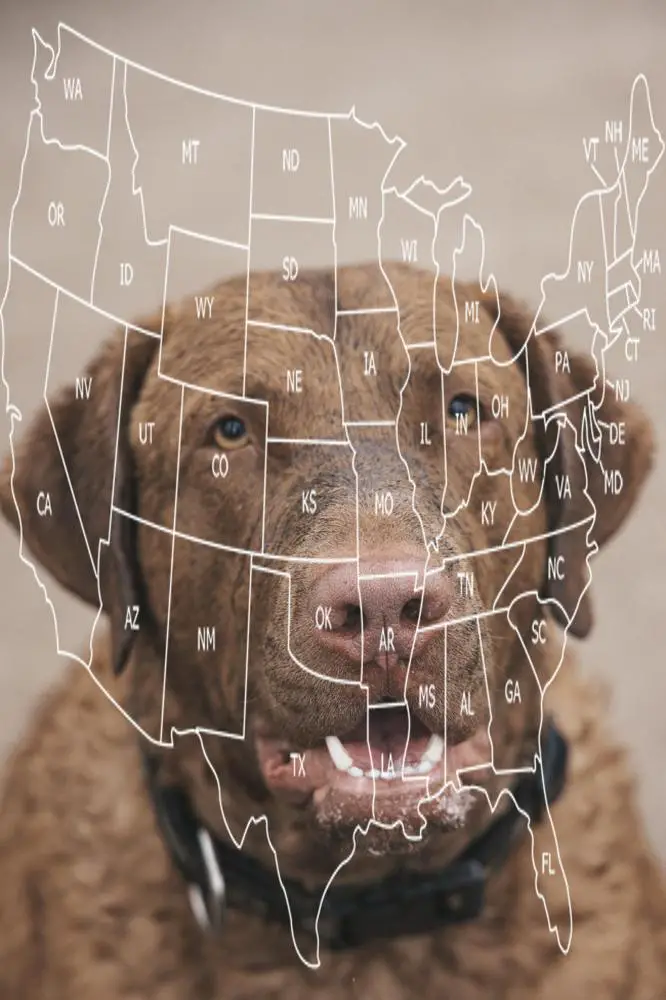
We have researched reputable Chesapeake Bay Retriever breeders that you can buy a puppy.
Go to this page for our complete list of reputable Chesapeake Bay Retriever breeders in various states in the United States.
On this page, you will see how much these breeders sell their puppies for, and how many puppies they have available.
A few of these breeders are listed below.
dan reavis
Puppy Price: $1200
Katie Gosen
Puppy Price: $1,200
David Childers
Puppy Price: $1500.
Rebecca Matsko
Puppy Price: $1200
TakeMeHome Retrievers
Puppy Price: Check with breeder
Adopting or Rescuing the Chesapeake Bay Retriever
You may consider adopting a dog instead of buying a puppy. Many dogs, Chesapeake Bay Retrievers included, are currently available for adoption in your local dog shelters.
These helpless but adorable dogs are waiting in dog shelters hoping that someday someone will rescue them. Dog adoption costs are lesser than the cost of a new puppy. Dog adoption costs are usually around $300 or even less.
In addition to your local dog shelter, another good place to find dogs that are available for adoption is petfinder.com.
Below is an adorable Male Chesapeake Bay Retriever named Da 39 Remington that is currently available for adoption on Petfinder.com. You can find other lovely Chesapeake Bay Retrievers like Da 39 Remington on pefinder.com.

Ranger is the name of another Chesapeake Bay Retriever (Male) on petfinder.com that is looking for a new forever home.
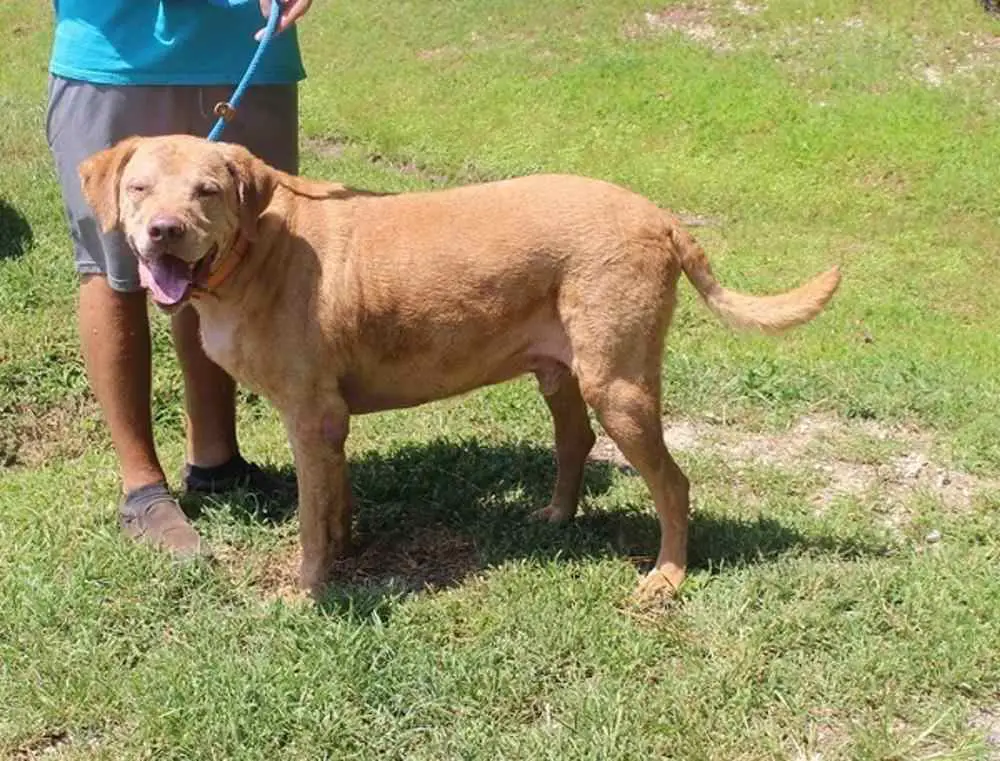
You can find more Chesapeake Bay Retrievers that are available for adoption on petfinder.
What Colors do Chesapeake Bay Retrievers Have?
Chesapeake Bay Retrievers come in the following beautiful primary colors:
- Brown / Chocolate
- Black
- Red / Chestnut / Orange
The Temperament of the Chesapeake Bay Retriever
The temperament of the Chesapeake Bay Retriever based can be summarized as in the table below.
The table shows the scores of the Chesapeake Bay Retriever for 13 important dog behavioral factors.
We obtained these scores by analyzing raw data from the C-BARQ dog personality survey tool. The higher the score of a dog for a factor, the worse the temperament of the dog regarding that factor.
The C-BARQ tool was developed by researchers from the University of Pennsylvania, and it is a scientific tool that is used worldwide for reliably measuring the temperament of dog breeds.
See our complete analysis of the temperament of the Chesapeake Bay Retriever here.
| Factor | Score |
|---|---|
| Attachment Attention Seeking | 71.8 percent |
| Energy Level | 70.1 percent |
| Dog Directed Aggression | 69.3 percent |
| Prey Drive | 63.3 percent |
| Stranger Directed Aggression | 62.9 percent |
| Dog Rivalry | 61.3 percent |
| Excitability | 54.0 percent |
| Touch Sensitivity | 34.5 percent |
| Dog Directed Fear | 30.4 percent |
| Owner Directed Aggression | 28.2 percent |
| Separation Related Behavior | 26.0 percent |
| Stranger Directed Fear | 21.8 percent |
| Stubbornness | 21.1 percent |
| Nonsocial Fear | 18.3 percent |
How Long Chesapeake Bay Retrievers Live
The lifespan of the Chesapeake Bay Retriever is typically from 10 to 12 years.
Moreover, a few years back, veterinarian researchers performed a scientific study to determine the lifespan of the Chesapeake Bay Retriever. In this study, the scientists collected data on how long 45 pet Chesapeake Bay Retrievers lived.
From the study, it was found that Chesapeake Bay Retrievers have an average lifespan of 10.7 years. Furthermore, the study found that it is not uncommon for Chesapeake Bay Retrievers to live as long as 15.6 years.
Note that you need to put in some effort if you want your Chesapeake Bay Retriever to live long.
Chesapeake Bay Retrievers live long if they eat well, drink well, exercise well, and visit the veterinarian regularly.
There are also dog supplements that you can give your Chesapeake Bay Retriever to improve your Chesapeake Bay Retriever`s quality of their life.
Click here to learn more about how to make your Chesapeake Bay Retriever live long.
Chesapeake Bay Retriever Litter Size
Researchers from the Norwegian School of Veterinary Science did a study where they counted the numbers of puppies in 6 different Chesapeake Bay Retriever birth litters.
From this study, the researchers found that the average number of puppies that Chesapeake Bay Retrievers can have is 6 puppies. Also, the Chesapeake Bay Retriever can have as few as 4 puppies per litter and as many as 11 puppies per litter.
The number of puppies that the Chesapeake Bay Retriever will have depends on factors such as the age of the Chesapeake Bay Retriever, the method of pregnancy, etc.
Click here to see our calculator for predicting how many puppies your Chesapeake Bay Retriever will have and how the litter size of the Chesapeake Bay Retriever compares to the litter size of other dog breeds.
How Fast Chesapeake Bay Retrievers Can Run

How fast a dog breed can run is a good measure of how athletic the dog breed is.
The American Kennel Club (AKC) regularly conducts dog running competitions. The AKC records the running speed of competing dogs in these competitions. These competitions are open to all dog breeds.
Based on our analysis of the speeds of 68 different Chesapeake Bay Retrievers, the average speed of the Chesapeake Bay Retriever is 25.1 mph (40.4 kmph).
The fastest speed on AKC record that the Chesapeake Bay Retriever ran in a race is 29.28 mph (47.1 kmph) and the minimum speed on record in a race for a Chesapeake Bay Retriever is 9.17 mph (14.8 kmph).
Click here to see how the speed of the Chesapeake Bay Retriever compares to the speed of other dogs and other mammals such as cats, horses, humans, etc.
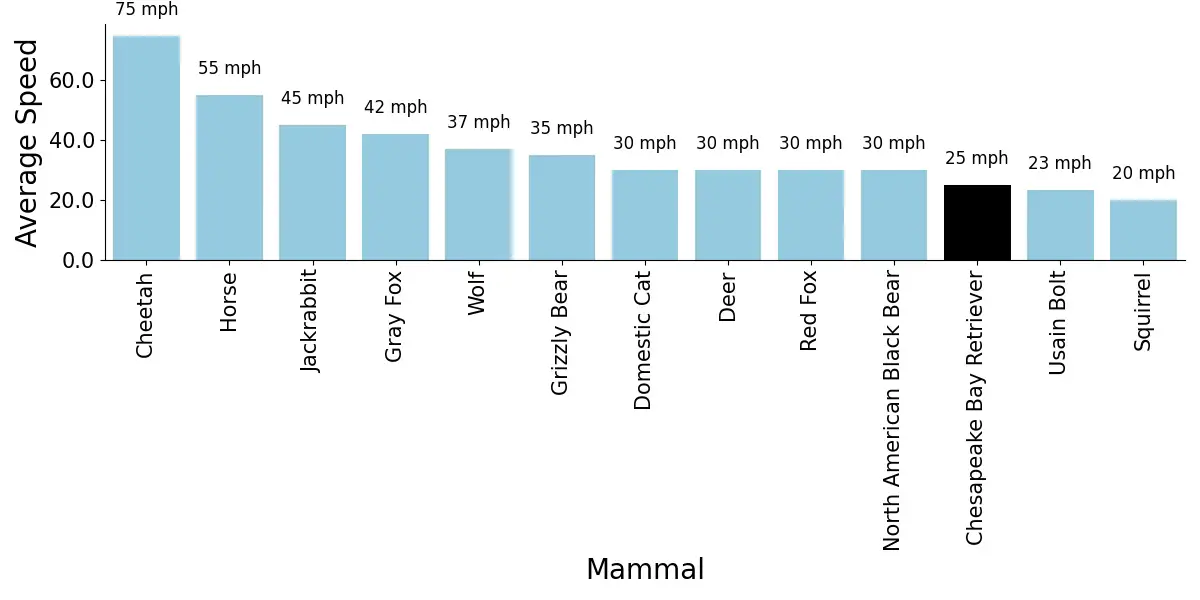
Good Names for Chesapeake Bay Retrievers
Here are some really good names that are typical for the Chesapeake Bay Retriever ranked by popularity:
- Dakota
- Mai
- August
- Periwinkle
- Grizzly
- Courtesy
- Dundee
- Shiitake
- Ranger
- Aries
How Intelligent are Chesapeake Bay Retrievers?
| Chesapeake Bay Retriever | |
|---|---|
| Intelligence Rank | 27 out of 130 dog breeds |
| Trainability | Tend To Learn New Commands After 15 To 25 Repetitions |
According to Prof. Stanley Coren, a Canadian psychology professor/dog trainer, the total intelligence that a dog demonstrates is the addition of three types of intelligence. These intelligence types are:
- Instinctive Intelligence: This is the natural intelligence that comes from instinct. For example, dog breeds that have been historically bred to be guard dogs will have a high `guarding` intelligence compared to dogs that were not bred for guarding.
- Adaptive Intelligence (learning and problem-solving ability): This indicates what a dog can learn to do for himself or herself. Adaptive intelligence is specific to each dog, and not breed specific. You can improve your dog`s adaptive intelligence by investing time to train your dog.
- Working/Obedience Intelligence: This type of intelligence is breed-specific. Certain dog breeds tend to have higher working/obedience intelligence than some other breeds. This intelligence is the closest to what we might call school-learning ability and it is based upon what the dog can learn to do when instructed by humans. This type of intelligence can be measured for each dog breed and compared to that of other dog breeds.
Professor Stanley Coren measured and ranked the working intelligence of about 130 different dog breeds.
Prof. Coren found that the Chesapeake Bay Retriever has an obedience intelligence rank of 27 out of 130 dog breeds. Thus, Prof. Coren put Chesapeake Bay Retrievers in the `Above Average Working Dogs` category.
This means that Chesapeake Bay Retrievers tend to learn new commands after 15 to 25 repetitions.
However, we should mention that a dog should not be judged based on its intelligence alone. There are other important factors you need to consider when deciding on which dog breed to get. These other factors include sociability, adorability, and compatibility of the dog breed with your lifestyle.
See the intelligence ranking of some other dog breeds below:
| Breed | Intelligence Rank |
|---|---|
| Labrador Retriever | 7 |
| Miniature Schnauzer | 12 |
| Collie | 16 |
| German Shorthaired Pointer | 17 |
| Irish Water Spaniel | 24 |
| Chesapeake Bay Retriever | 27 |
| Samoyed | 33 |
| Affenpinscher | 37 |
| Norwich Terrier | 38 |
| Finnish Spitz | 43 |
| Chinese Shar-Pei | 51 |
| Rhodesian Ridgeback | 52 |
| Ibizan Hound | 53 |
| Akita | 54 |
| Norfolk Terrier | 56 |
| Italian Greyhound | 60 |
| Chinese Crested | 61 |
| Saint Bernard | 65 |
| Bloodhound | 74 |
| Basenji | 78 |
How Popular are Chesapeake Bay Retrievers with New Dog Owners?
Every year, the American Kennel Club (AKC) publishes information on how popular a dog breed is in that particular year. The AKC gets the popularity information of a breed from how many dogs of that breed the owners register with the AKC every year. The AKC collects this data for about 200 dog breeds.
The graph below shows the popularity trend of the Chesapeake Bay Retriever.
The popularity of the Chesapeake Bay Retriever averaged over the years is Number 44 out of about 200 dog breeds.
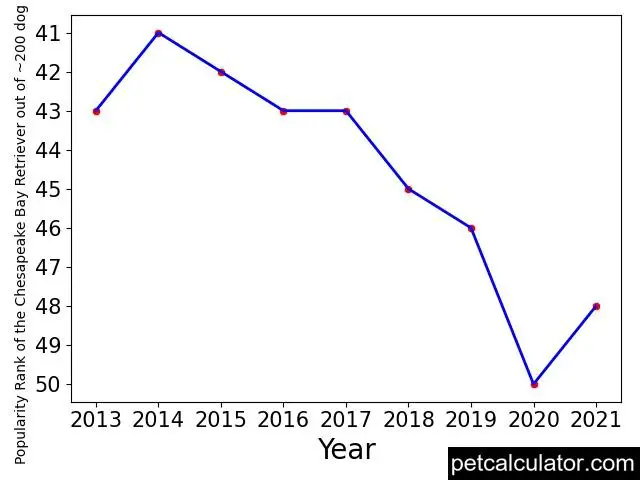
Do not get a dog breed just because it is a popular dog breed. And do not reject a dog breed just because it is an unpopular breed.
Health Problems in Chesapeake Bay Retrievers and How to Prevent Them
Every dog breed has its own set of health problems that it tends to develop. There is nothing like a perfect dog breed.
The Chesapeake Bay Retriever is prone to certain genetic health conditions. The Orthopedic Foundation for Animals (OFA) is an organization that keeps track of genetic health problems in dog breeds.
From the extensive records that the OFA keeps, the OFA knows what health problems each dog breed is naturally prone to develop.
Hence, the OFA recommends which health screening breeders should perform on a dog breed to make sure that the breeders won`t breed `defective` dog parents that can pass down defective genes to their puppy offspring.
If you want a Chesapeake Bay Retriever puppy that will grow up to be healthy, make sure that your Chesapeake Bay Retriever breeder screens your puppy or your puppy`s parents for the health problems that the OFA recommends for your puppy`s breed. This will increase the chances that your puppy is free from genetic defects.
The following are the health tests that Orthopedic Foundation for Animals (OFA) recommends that breeders should screen Chesapeake Bay Retrievers for:
- Autoimmune thyroiditis
- Cardiac Evaluation
- Degenerative Myelopathy
- EIC (Exercise Induced Collapse)
- Elbow Dysplasia
- Eye Examination- after the age of 12 months
- Hip Dysplasia
- Progressive Retinal Atrophy (PRA) DNA Test
You can find out more about OFA`s recommended tests for Chesapeake Bay Retrievers here.
Dog Breeds That Are Similar to Chesapeake Bay Retrievers
If you have not made up your mind on which dog breed to get, you may also want to consider some other dogs similar to the Chesapeake Bay Retriever.
We crunched the numbers and found that the following dog breeds that have similar behavior and temperament as the Chesapeake Bay Retriever:
- Hovawart (74 percent match with Chesapeake Bay Retriever). Learn more about the Hovawart here.
- Karelian Bear Dog (73 percent match with Chesapeake Bay Retriever). Learn more about the Karelian Bear Dog here.
- Boerboel (76 percent match with Chesapeake Bay Retriever). Learn more about the Boerboel here.
Other Things to Know About Chesapeake Bay Retrievers
Here are some of the very important characteristics of the Chesapeake Bay Retriever that you need to know about the Chesapeake Bay Retriever breed:
